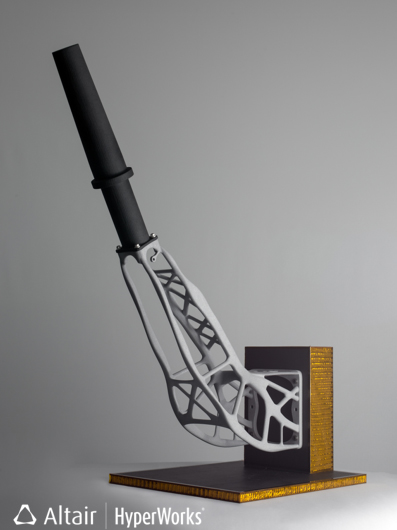
Using Altair’s HyperWorks software, RUAG space agency redesigned an optimized antenna bracket for its Sentinel-1-Satellite. The finished design was manufactured in 3D printing.
Latest News
June 11, 2015
 Using Altair’s HyperWorks software, RUAG space agency redesigned an optimized antenna bracket for its Sentinel-1-Satellite. The finished design was manufactured in 3D printing.
Using Altair’s HyperWorks software, RUAG space agency redesigned an optimized antenna bracket for its Sentinel-1-Satellite. The finished design was manufactured in 3D printing.If you plan to produce a part using injection molding, you can simulate the injection-molding process using Autodesk Moldflow or a similar type of software. If you’d rather cut the part out of a piece of metal, you can use any of the commercially available computer-aided manufacturing (CAM) programs to simulate the machining process.
In doing so, you’d be able to identify potential manufacturing problems—the air pockets that might form in the molding process, the regions the cutting tool would have trouble reaching, and so on—and fix your part’s geometry before you go into production. But what if you plan to print your part out in a 3D printer?
For toys, experimental gadgets, and hobby projects, the combination of CAD and the 3D printer’s firmware may be sufficient. For industrial-scale 3D printing projects, the type aerospace and automotive manufacturers want to explore, the option to simulate the production process is severely limited. That’s one of the topics participants would tackle in the 3D Printing Forum at the upcoming NAFEMS World Congress 2015 (June 21-24, San Diego, California).
Georg Schoepf, a NAFEMS member and organizer of the 3D Printing Forum, said, “There is a need for the simulation software developers to bring additional tools for AM, similar to special solutions for injection molding. The AM build process brings up new problems with it. For instance, there are temperature considerations, because FDM (fused deposit modeling), SLS (selective laser sintering), and SLM (selective laser melting) work with melting materials. We also have to think of chemical influences on the process.”
Baljesh Mehmi, Altair‘s director of HyperWorks, said, “With 3D printing, you can produce truly organic structures—designs that are optimized for lightweight and performance.”
Mathematically derived optimal topology tends to fall outside the range of perfect circles, squares, and rectangles achievable with traditional manufacturing methods. Altair, which specializes in developing simulation software for design optimization, has a vested interest in the proliferation of additive manufacturing (AM) because it is one of the few ways to produce unorthodox shapes at a reasonable cost.
For the foreseeable future, “Most parts will still be made in traditional machining,” Mehmi acknowledged, partly because “There’s still a need to qualify the [AM] process for actual usage.” However, he added, “Manufacturers can start to figure out where AM can be effective in the production workflow.”
Schoepf believes a lack of “usable material models for parts made by AM” is a stumbling block. He explained, “Materials react in different ways depending on the building method. So the developers of materials have to define the properties that come with each method. They also have to define how the building method influences structural mechanical properties. In some cases, the mounting position of the part during the build process affects the shear the part can endure.”
Similarly, Mehmi observed, “The metallurgy involved in AM—what happens to the materials in the printing process—is an unknown area in simulation. We can’t yet simulate what happens to the particles when they’re heated, melted, and cured.” The simulation industry needs a thorough understanding of the transformation to develop software that can predict the deformation, stress distribution, and fatigue in 3D-printed parts.
In certain industries like healthcare and life sciences, both the production process and the materials involved must pass rigorous testing and certification before they can be used to made products offered to the public. As a relatively new manufacturing process, AM is under observation by regulatory bodies like FDA. Some 3D printer materials, however, have been approved for prostheses and implants.
Altair recently added the ability to generate lattice structures in its software Optistruct. “This is one of our efforts to be responsive to customers,” said Mehmi. “Some in automotive industry have requested that function.”
Lattice structures are difficult (some would say impossible) to produce in traditional machining. However, they can be produced in AM. For producing lightweight vehicles and planes, the porous lattice structures offer tremendous advantages over parts built with solid geometry. But the ability to automatically fill specific regions with lattice structures is still a rarity in mechanical modeling programs.
Schoepf said the talks at the 3D Printing Forum will cover issues related to 3D printing materials and AM’s influence on the design process for lightweight structures. Dr. Ming Zhou, Altair’s senior VP of software development, is participating in the Forum at NAFEMS.
To register to attend NAFEMS World Congress, go to http://nafems.org/congress.
For more on the link between optimization and 3D printing, you can register for DE‘s upcoming webinar, titled “Optimization and 3D Printing Revolutionize Design.”
Subscribe to our FREE magazine, FREE email newsletters or both!
Latest News
About the Author
Kenneth Wong is Digital Engineering’s resident blogger and senior editor. Email him at [email protected] or share your thoughts on this article at digitaleng.news/facebook.
Follow DE





